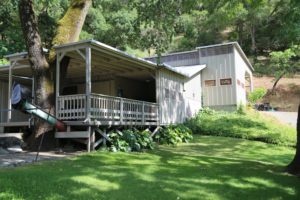
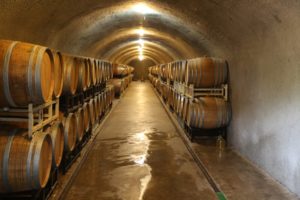
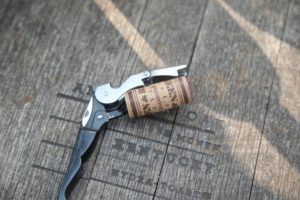 Green and Red Vineyard was founded in 1977 by Jay Heminway (died in June 2019), leaving the winery to be run by his wife Pam and daughter Tobin and her husband Raymond. Tobin has enjoyed a career as a film producer and editor in New York and Raymond was a General Counsel who now describes himself as a ‘cellar rat’ helping out with numerous details both in the vineyard and in the cellar.
Green and Red Vineyard was founded in 1977 by Jay Heminway (died in June 2019), leaving the winery to be run by his wife Pam and daughter Tobin and her husband Raymond. Tobin has enjoyed a career as a film producer and editor in New York and Raymond was a General Counsel who now describes himself as a ‘cellar rat’ helping out with numerous details both in the vineyard and in the cellar.
During his junior year in college in 1960 he worked at Château Lascombes in Bordeaux, primarily in the vineyards. Incidentally Château Lascombes is now owned by another Napa vintner, Gaylon Lawrence. In the 1960s Jay was a graduate student, studying sculpture U.C. Berkeley. After graduating, Jay remained with the university and taught a sculpture class. Some of his works were on display during select art shows or in exhibitions in the San Francisco Bay Area in the 1960s including one of his sculptures in the contemporary exhibition titled, West Coast Now, hosted at the de Young Museum in San Francisco in 1968. It was during this time that he developed an appreciation of both food and wine.
After visiting Napa Valley, he discovered this property and in 1969 purchased it. This land is located in the steep Chiles Canyon near Chiles Valley, about a 20-minute drive east of the valley floor. By this time, he already had experience working in the wine industry with stints in Bordeaux, France and selling wine in New York City (where he was raised) for Sherry-Lehman, Inc. However, he did not purchase the property with the intent on making wine – that came later as it has for a number of other generations who moved to the region and become “bitten” with the allure of Napa Valley.
Grapes had been planted on the property long before Jay purchased it, with vines first planted in the 1890s from when the property was part of the original Rancho Catacula land grant. This land grant was given to early Napa Valley settler Colonel Joseph B. Chiles in 1844 for $10 and is who Chiles Valley is named for. Chiles was born in Kentucky in 1810, the grandson of two Revolutionary War Captains and whose lineage in the U.S. is traced back to 1637.
Remarkably Chiles made 7 round trip wagon crossings from Missouri to California; the first time he saw Chiles Valley was in 1841 several years prior to his building a log cabin, followed by an adobe house and the Chiles Mill, all constructed in the 1840s. He spent his time at his rancho here, but also had several homes in St. Helena and Rutherford and a place in Lake County. And his original adobe is incredibly still standing; it is a private residence off of Chiles Pope Valley Road on what is known as the Dollar Ranch. Robert Stanley Dollar Jr. purchased what previously was the E.H. Krause Ranch in 1964. The Dollars still own this ranch and grow grapevines and sell the fruit; the family founded Dollar Shipping in San Francisco which became a part of American President Lines in 1938. This is one of only two adobes still in existence in Napa County dating from the 1840s – the other is the Cayetano Juárez Adobe built in 1845 in the city of Napa. It currently houses Le Chevre Restaurant.
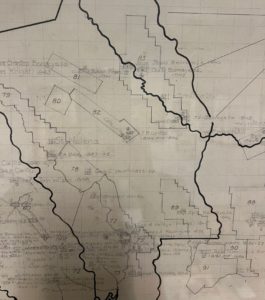
Thank you to Tobin for this photo of a map at Hendry Winery including the location of the Chiles Adobe. George W. Hendry documented plant material found in old California adobes
Chiles was also in business with Jerome Davis, the namesake of the town of Davis in Yolo County. And in addition to the Chiles roads in Chiles Valley, several other roads are named in his honor including Chiles Ave in St. Helena and Chiles Road and Davis. He died in 1885 leaving 10 children and according to his obituary in the June 26, 1885 issue of the St. Helena Star, “his funeral today was the largest ever seen in Napa County”.
Several of Chiles descendants have written books about the man and his life. Those interested in learning more about Chiles can read the out of print book titled, Trail-Blazing Pioneer Colonel Joseph Ballinger Chiles by Helen S. Griffin published in 1969. Only 750 copies were printed. And in 2018, Frederick Chiles authored, Forgotten Trailblazer: Joseph B. Chiles and the Making of California.
The original wooden Chiles Grist Mill was built in 1846 using logs harvested from trees on Howell Mountain. Another early Napa pioneer, William Baldridge, a millwright and for a short time, business partner of Chiles assisted in its design and construction. Baldridge joined Chiles in 1843 and came to California by wagon train. Incidentally, Baldridge’s home is still standing on the grounds of what is now The Vineyard House Winery near Oakville. The Chiles Mill was in use through the 1880s. Vandals weakened some of its wooden supports in 1939 when they stole the large 20′ x 6′ England made flour sifter; when a strong storm blew through Napa Valley in February 1940, the second story of the wooden mill was blown off. By 1963 the old mill was just a, “tumbled up pile of lumber” according to an article in a March issue of the Napa Register.
Remains, Chiles Mill
Millstone, Chiles Mill
Chiles owned homes, Napa Valley
Chiles gravesite, St. Helena Cemetery
Part of Green & Red’s Chiles Mill Vineyard overlooks the mill site. Only the remains of the foundation are still standing on both sides of Chiles Creek. Historical state landmark plaque number 547 marking the Chiles Grist Mill installed in 1956 is located within a few feet of Lower Chiles Road just up a small hill (coordinates: 38.535259,-122.337216). One of Chile’s grandsons, Henry Lee Chiles bulldozed the flat section in the hill for the monument and provided the large rock for the plaque. And fittingly, one of Chile’s granddaughters, Mrs. Bixie Bell Rea pulled off the canvas cover to unveil the plaque.
The Bale Grist Mill is the only surviving Napa Valley grist mill; it was built in 1846. The Chiles Grist Mill had a larger production during its operation; its construction began in 1845. The mill stone from Chiles Mill used to be displayed at the Academy of the Sciences at Golden Gate Park in San Francisco. However, in 2018 the original French made Burh bed stone from Chiles Mill was donated to the Bale Grist Mill State Historic park in remembrance of Chile’s great granddaughter, Peggy Chiles.
Another Napa Valley grist mill was George Yount’s mill near Yountville; two of the grinding stones from his Star of the Pacific Mill survived and are on display for the general public, outdoors in front of the Yountville Community Center.
Jay bonded his winery in 1977 and also made his first vintage of wine that same year; (300 cases of 1977 Zinfandel, all pressed in a basket press and bottled by hand). Incidentally, this was the same year as Grgich Hills was founded; at that time, there were under 30 wineries in operation in the Napa Valley. The limited numbers of wineries in the valley were a direct result of Prohibition which ended some 46 years earlier. Since Jay started Green & Red, things have certainly changed in a mere four+ decades with now more than 1,000 ‘producers’ making wine commercially based in Napa Valley of which there are some 500+ physical wineries.
Jay tasted plenty of Cabernet Sauvignon based wines by the early 1970’s but it was several Zinfandels that caught his attention. He tried two late 1960’s vintages of Zinfandel – impressive wines that helped persuade him to move to the Napa area; one was from at that time the newly reborn Mayacamas Winery and the other was from Sutter Home, made from purchased fruit from the very historic Deaver Vineyard in Amador County.
Today the majority of Green & Red’s vineyards are planted to Zinfandel; additional varieties include Sauvignon Blanc, Petite Sirah, Syrah and a very tiny block of Viognier. Green & Red does not grow or make Cabernet Sauvignon. Jay planted his first Zinfandel vines in 1972 – on their own rootstock. Ultimately these first vines were infected with phylloxera requiring a full replant to phylloxera resistant rootstock. One vine however survived – the one that was planted on a resistant rootstock – and continues to produce, some 45+ years later.
Initially Jay made home wine from his fruit and sold grapes to other producers including Cuvaison and to Philip Togni. Today Green & Red Vineyard still sells grapes to the who’s who of primarily Zinfandel producers including Turley, Biale Vineyards, Ridge Vineyards and previously to the nearby Brown Estate.
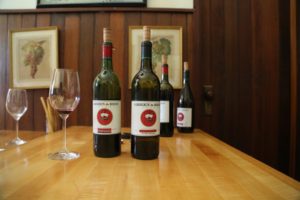
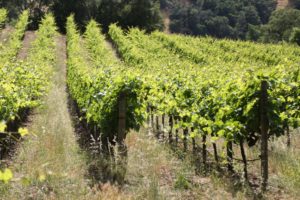 Green & Red is the only winery in Chiles Canyon; the property is just under 200 acres of which about 31 are planted to vines distinguished between three unique vineyards – all at different elevations and exposures; Chiles Mill (the first vineyard Jay planted), Catacula (the second vineyard planted) and lastly, Tip Top (named for its highest elevation).
Green & Red is the only winery in Chiles Canyon; the property is just under 200 acres of which about 31 are planted to vines distinguished between three unique vineyards – all at different elevations and exposures; Chiles Mill (the first vineyard Jay planted), Catacula (the second vineyard planted) and lastly, Tip Top (named for its highest elevation).
And while it sounds nice, the name green and red does not refer to various hot chili peppers growing in the Chiles Valley. Chil is pronounced like it sounds when saying the world child and not chili peppers; or for additional pronunciation clarification, Chiles rhymes with miles. Rather, their name reflects their sense of place. The color green refers to the greenish serpentine in their soils and the red is reflective of the reddish iron rich soils (decomposed chert material). The vines grow well in the reddish soils but the greenish serpentine is not conducive for growing grapes or many other plants. The vegetation growing on these greenish rocky soils tends to be sparse.
Some of the nearby hills that surround their vineyards are extremely red. Seen in person, these reddish hills dominate above the vineyard and are among the reddest hills we have seen in Napa County. The vineyards range in elevation from 900 to 1800 feet. The uppermost part of their vineyard is the second highest vineyard in the Chiles Valley sub appellation. The nearby upper reaches of the Phelan Vineyard is slightly higher. Because of this elevation spread, fog sometimes is a moderating influence on the lower vineyards as it rolls up the canyon.
Compared to the heart of Napa Valley Chiles Canyon has remained fairly unchanged. Airline miles, it’s not that far from the actual valley floor, but narrow winding roads, the steep canyon and its eastern location help ensure that this part of Napa has and will remain fairly undeveloped.
Jay was a pioneer grape grower in this part of Napa Valley – he was one of the first of the “modern” growers to move into the area (grapes were grown in nearby Chiles Valley dating back to the 1870s). He was instrumental in securing an American Viticultural Area (AVA) for this region in 1999, called Chiles Valley. His upper most vineyard (Tip Top) at 1,800 feet is the highest vineyard in Chiles Valley.
Solar panels on site help power irrigation and other vineyard needs. The winery & cave is small, about 6000 cases are produced annually with the bulk of that production being Zinfandel with much more limited production wines of Sauvignon Blanc, Syrah and Petite Sirah.
Select Wines
A special barrel room is used only for their select white wines. The 2020 Green & Red Vineyard Napa Valley Viognier, Catacula Vineyard is a northeast facing vineyard ranging in elevation from 1200 to 1400 feet above sea level. Only 1/2 an acre of this variety is planted so production is extremely limited each year. This wine is deep straw in color with very forward floral aromatics of jasmine and citrus blossom. Also, there is a sweeter honey dew melon note, especially as the wine evolves in the glass. Soft with a slightly creamy texture across the palate – its mouth feel is complemented nicely by the brightness of acidity and minerality nuances. Offers flavors of lemon/lime (without being tart or grassy), green apple and kiwi. The liveliness on the finish is an appealing characteristic of this wine.
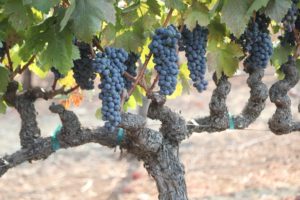
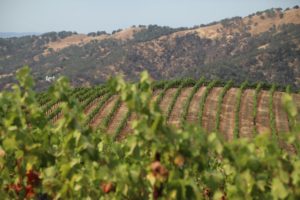
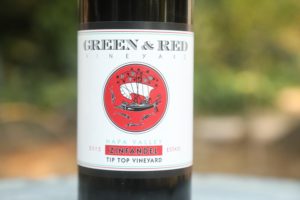 The 2019 Green & Red Vineyard Napa Valley Sauvignon Blanc is planted in a two-acre block in their Catacula Vineyard at 1400 feet. This wine is entirely Sauvignon Musqué clone. Pale to medium gold in color the bouquet offers aromas of a recently mowed lawn, citrus blossom, pomelo and green apple, opening as the wine breathes to some floral notes including jasmine and honeysuckle. This wine preserves the freshness of the varietal characteristics quite well, while simultaneously showcasing the sunshine of Napa Valley on the palate, rather than an expected leaner style flavor profile. Very well balanced with flavors of Golden Delicious apple, pear and mandarin. Bright on the finish, the wine begs another sip.
The 2019 Green & Red Vineyard Napa Valley Sauvignon Blanc is planted in a two-acre block in their Catacula Vineyard at 1400 feet. This wine is entirely Sauvignon Musqué clone. Pale to medium gold in color the bouquet offers aromas of a recently mowed lawn, citrus blossom, pomelo and green apple, opening as the wine breathes to some floral notes including jasmine and honeysuckle. This wine preserves the freshness of the varietal characteristics quite well, while simultaneously showcasing the sunshine of Napa Valley on the palate, rather than an expected leaner style flavor profile. Very well balanced with flavors of Golden Delicious apple, pear and mandarin. Bright on the finish, the wine begs another sip.
The 2018 Green & Red Vineyard Napa Valley Zinfandel Chiles Canyon Vineyards is a blend of all three of Green & Red Vineyard’s sites. The wine is dark ruby in color; offers a mix of both dark fruits and darker spices along with aromas of old cedar box and pepper. Hints of mocha show, deeper into the aromatics. Somewhat savory in its aromatic profile. Shows a little heat on the finish (15.1% alcohol), but overall, this is a balanced wine that tastes like Zinfandel. Offers flavors of red cherry and red licorice. The palate is not as savory as the bouquet. The light grip of tannins is earthy, rounded and very well integrated on the finish.
The 2016 Green & Red Vineyard Napa Valley Syrah Tip Top Vineyard is inky dark ruby/purple in the glass. This wine is from a 2-acre terraced block with vines growing in red and rocky soils. The aromatics are powerful with darker fruits including spicy plum, ripe blackberry and blueberry along with notes of black pepper and old cedar box. Also shows aromas of Asian five-star spices. Features plenty of fruit across the palate including of plum and black licorice. Lingers with darker tannins showing a reasonable amount of grip along with notes of black pepper and toasted cedar. Features a savory and mouthwatering finish. Fire up the flame, cover the grill with tri-tip, cook to perfection and drink copious amounts of this wine.
The 2016 Green & Red Vineyard Napa Valley Petite Sirah Tip Top Vineyard is from a 2-acre block planted at 1700 feet elevation on terraced slopes. The wine is medium to deep purple in color; the aromatics are simultaneously dark and fruit forward showing notes of mushroom, old leather, ripe plum, juicy blackberry and cracked peppercorn. Offers plenty of aromatic layering and becomes more fruit dominated as the wine evolves in the glass. Succulent across the palate, offers a richness of flavor without the heavy hand of tannins that sometimes one associates with this variety. Lingers with some bright berry flavors and noticeable mouth-watering freshness of acidity, along with a rounded medium grip of slightly chewy tannins. Lovely texture.
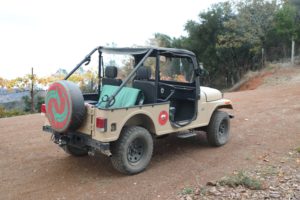
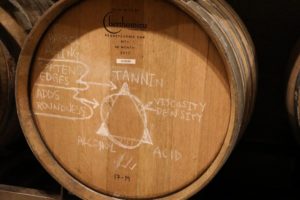 The 2015 Green & Red Vineyard Sauvignon Blanc is from a part of the property at about 1400 feet in elevation (the Catacula Vineyard) and this wine is made from the Musqué Clone of Sauvignon Blanc. Medium golden in the glass, the bouquet sports aromatics of dried straw, a lemon lime zest, paraffin, grapefruit, citrus blossom and a steely minerality. On the palate, offers a supple texture – rounded and soft with flavors of green apple, mandarin, orange and kiwi. Finishes bright with lemongrass and notes of lemon. Not tart – very balanced and drinks quite nicely by itself. Good acid but not bracingly so. Five years of age has been quite nice to this properly stored wine, and this is a good example that when made thoughtfully, Sauvignon Blanc can certainly age. Probably the best quality to price point Sauvignon Blanc consistently coming out of the Napa Valley.
The 2015 Green & Red Vineyard Sauvignon Blanc is from a part of the property at about 1400 feet in elevation (the Catacula Vineyard) and this wine is made from the Musqué Clone of Sauvignon Blanc. Medium golden in the glass, the bouquet sports aromatics of dried straw, a lemon lime zest, paraffin, grapefruit, citrus blossom and a steely minerality. On the palate, offers a supple texture – rounded and soft with flavors of green apple, mandarin, orange and kiwi. Finishes bright with lemongrass and notes of lemon. Not tart – very balanced and drinks quite nicely by itself. Good acid but not bracingly so. Five years of age has been quite nice to this properly stored wine, and this is a good example that when made thoughtfully, Sauvignon Blanc can certainly age. Probably the best quality to price point Sauvignon Blanc consistently coming out of the Napa Valley.
The 2015 Green & Red Vineyard Napa Valley Zinfandel Tip Top Vineyard is dark ruby in color; offers intense aromatics, meaty, gamey with notes of mushroom, old cedar plank, pepper and spicy plum. More fruit opens as the wine breathes in the glass. Smells like the variety. Opulent and juicy, this is a mouth filling expression of the richness of this variety. Offers plenty of spice notes across the palate including of pepper along with flavors of plum, blackberry and dark licorice. The tannins are earthy and feature a medium grip. They are persistent, but not course in their textural feel. A mouthwatering acidity lingers on the finish. We tried this six years post vintage date; it obviously has loads of life ahead of it still.
The 2014 Green & Red Chiles Mill Vineyard Zinfandel reveals a very elegant bouquet in its youth – aromas of blackberry and raspberry are complemented by floral notes and a hint of vanilla. The aromas are about the fruit rather than the oak. Bright fruit on the plate includes raspberry and plum with an earth driven characteristic (hints of pepper and dried herbs). Well integrated slightly dusty tannins and a peppercorn spiciness – along with a kiss of mocha anchor a pleasing and very smooth finish. This is a very well-balanced wine.

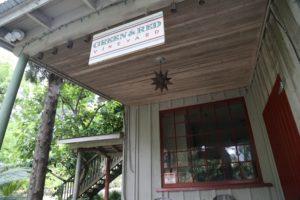
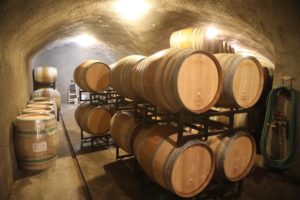 The 2007 Green & Red Sauvignon Blanc has nice floral notes on the bouquet with notes of mineralites from their unique terroir. This is followed by crisp pear and apple flavors on the palate with a hint of pineapple and spice towards the pleasing lingering finish. The wine was not put through malolactic fermentation, and it was was stirred on the lees during the barrel aging. This helps bring a nice weight to the palate.
The 2007 Green & Red Sauvignon Blanc has nice floral notes on the bouquet with notes of mineralites from their unique terroir. This is followed by crisp pear and apple flavors on the palate with a hint of pineapple and spice towards the pleasing lingering finish. The wine was not put through malolactic fermentation, and it was was stirred on the lees during the barrel aging. This helps bring a nice weight to the palate.
The 2006 Green & Red Chiles Mill Vineyard (named in honor of the nearby Chiles Grist Mill) Zinfandel offers pleasing spices on the nose including notes of black pepper and cloves and even a hint of rose petal. The spices continue on the palate, perhaps a little ginger with also some blackberry and plum flavors including a similar spiciness found in the skins of a Santa Rosa plum.
The label is Greek in origin adapted from a wine chalice that was painted in the 6th century B.C. A 1959 Château Léoville Barton Saint Julien label helped inspire the design of the Green & Red label. The winery still owns the original die cut used to make their wine label.
For the quality to price ratio, there is absolutely no question here – these are some of the best value limited-production wines in the entire Napa Valley.
Most of their production goes into restaurant and retail distribution in select markets across the country with lesser amounts sold direct. One of their noted restaurant accounts is the acclaimed Chez Panisse Restaurant in Berkeley, California. Chez Panisse, co-founded by noted chef Alice Waters celebrated their 50th anniversary in 2021, incidentally the same year we visited this restaurant for the first time due to their strong connection with Green & Red Vineyard.
Visits to Green & Red are by appointment and are scheduled around their winemaker or assistant winemaker’s schedule. Weather permitting, visitors are driven in a Mahindra built jeep to the upper most vineyard elevation part of their property. The roads are dirt and pass next to the steeply terraced vines. The views from here are gorgeous and panoramic of the surrounding hillsides. A small deck built around the trunk of an oak tree is an ideal place for enjoying several of their wines.
Visits may also include a walk into the wine cave; pieces of chalk are randomly located among some of the barrels. If visitors are feeling particularly creative, they may write short lines on some of the barrel heads.
In 2023, Green & Red began a wine club with two lovels of membership available – appropriately called the Green Tier (6 bottles, four times a years) and the Red Tier (12 bottles, four times a year). For more information and to join their mailing list, visit: www.greenandred.com
- The Green & Red flag
- Chilles Grist Mill historical plaque
- Original die cut for the Green & Red label
- Small lab






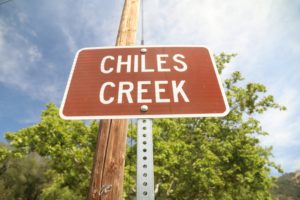
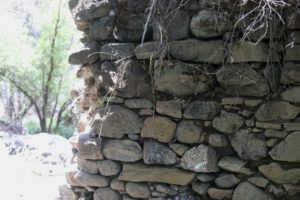
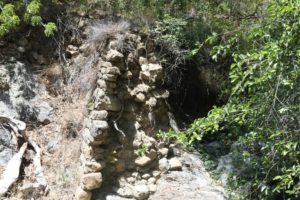
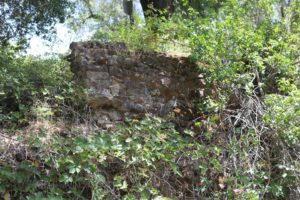
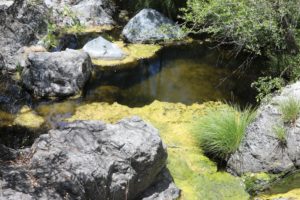
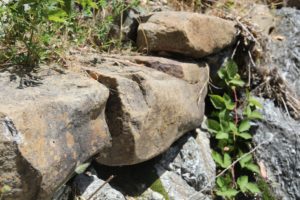
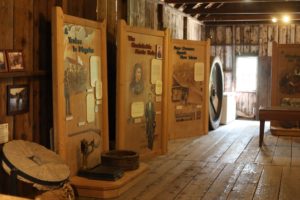
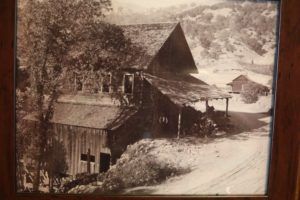
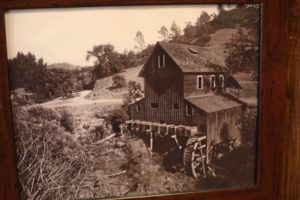
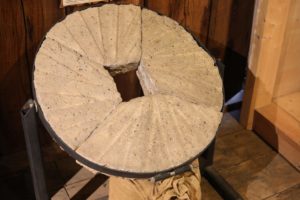
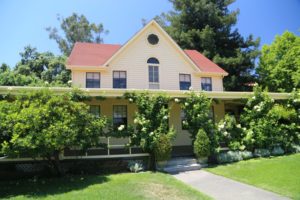
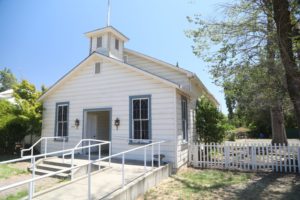
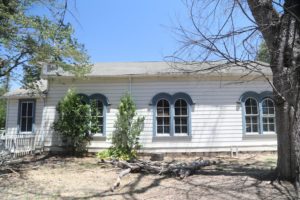
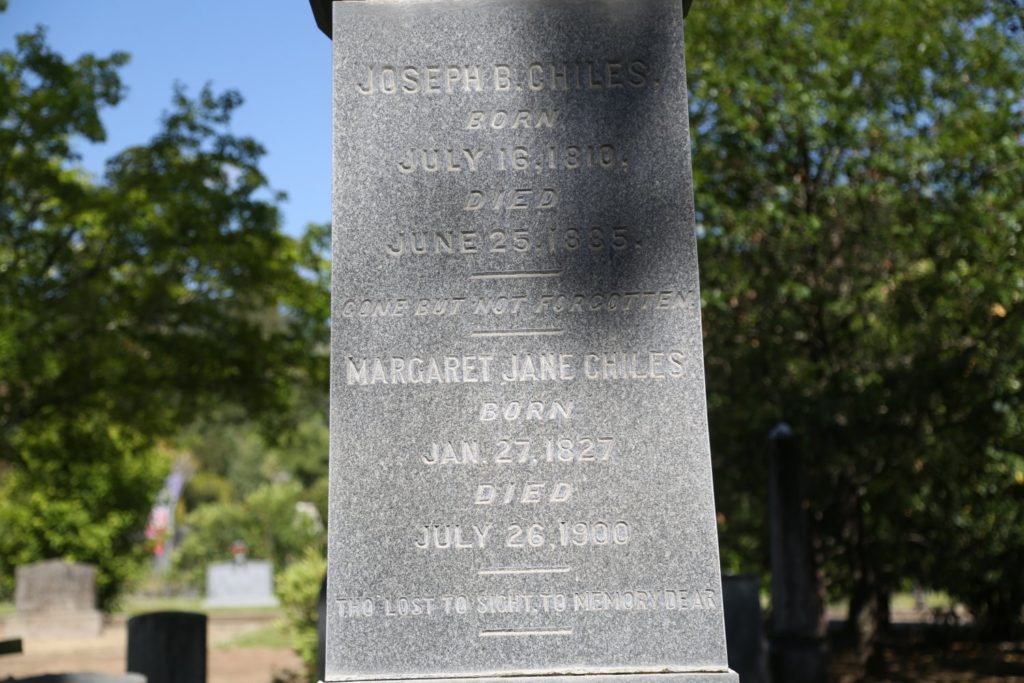
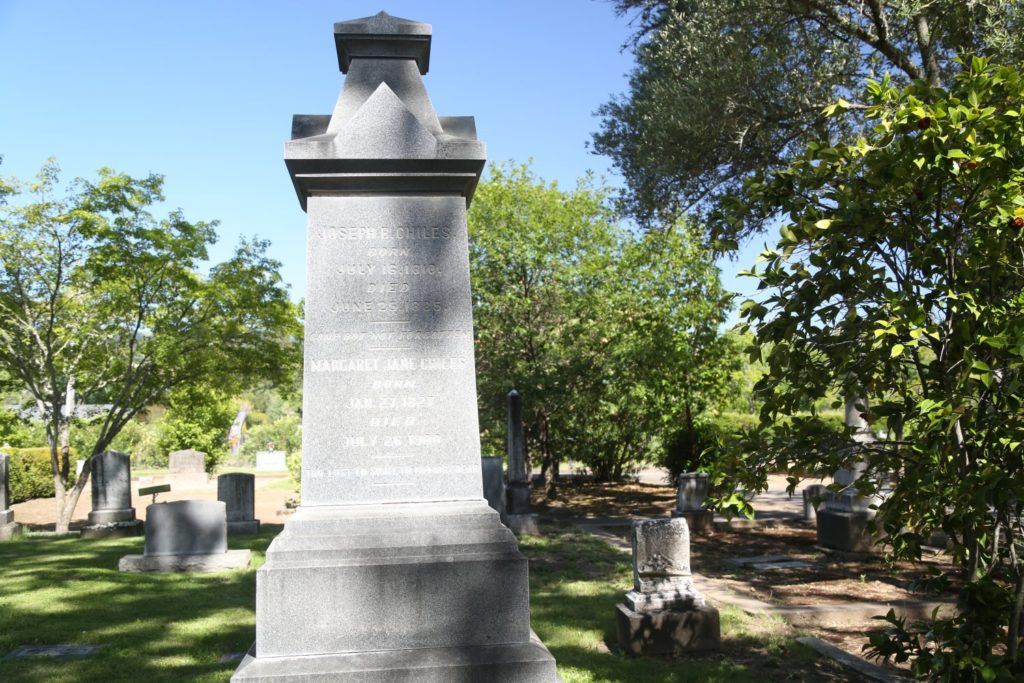
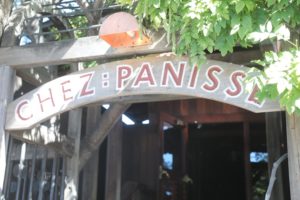
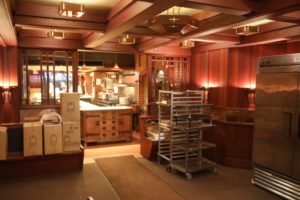
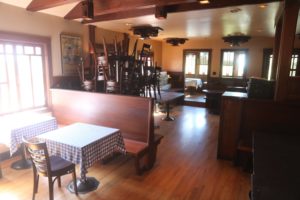
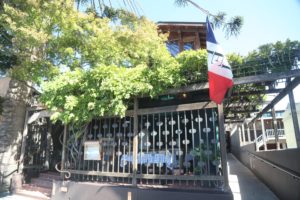
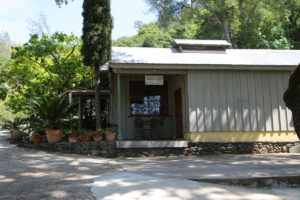
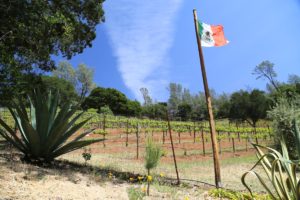
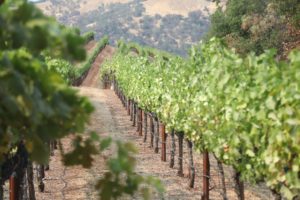
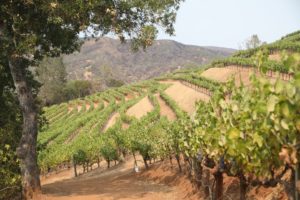
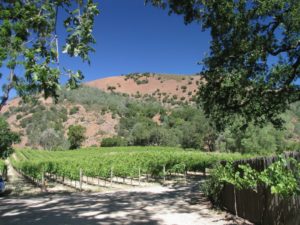
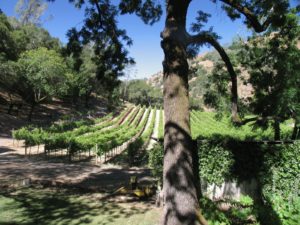
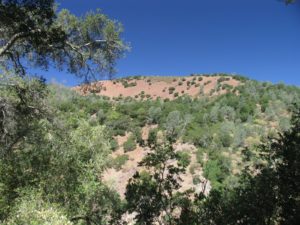
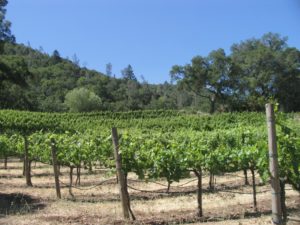
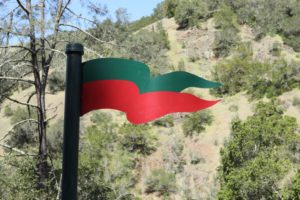
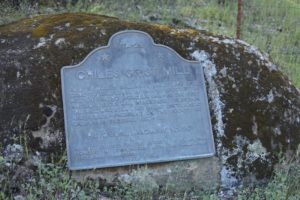
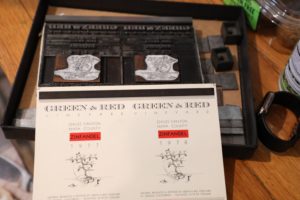
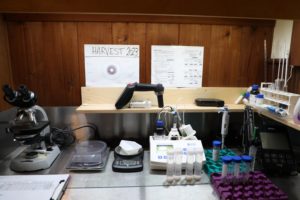
Can you tell me anything about Rancho El Adobe, Merlot 2010
The label has Green and Red Vineyard, St. Helena as the Bottler.
I love the cab. And want to know if I can get more.
Thanks for your help with this,
Phillip
I also loved this wine about six years ago and have not found it since. Have you?
This wine was bottled privately for the Dollar Ranch and must have been given to you. This was not a commercial wine. Glad you liked it.
I believe the Dollar Ranch that Jay refers to was named after R. Stanley Dollar, its owner who acquired the property in Chiles Valley in 1964 from E.H. Krause. Dollar was part of the famous Dollar Steamship Company family. And his property contained the original Rancho Chiles Adobe built by Joseph Chiles in 1845. And he owned the Dollar Ranch in Walnut Creek.